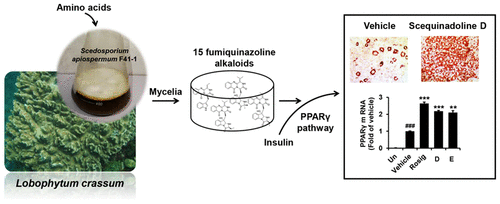当前位置:
X-MOL 学术
›
J. Nat. Prod.
›
论文详情
Our official English website, www.x-mol.net, welcomes your
feedback! (Note: you will need to create a separate account there.)
Potential Antidiabetic Fumiquinazoline Alkaloids from the Marine-Derived Fungus Scedosporium apiospermum F41-1.
Journal of Natural Products ( IF 3.3 ) Pub Date : 2020-03-04 , DOI: 10.1021/acs.jnatprod.9b01096 Chan-Juan Li 1 , Pei-Nan Chen 1 , Hou-Jin Li 2 , Taifo Mahmud 3 , Dong-Lan Wu 1 , Jun Xu 1 , Wen-Jian Lan 1
Journal of Natural Products ( IF 3.3 ) Pub Date : 2020-03-04 , DOI: 10.1021/acs.jnatprod.9b01096 Chan-Juan Li 1 , Pei-Nan Chen 1 , Hou-Jin Li 2 , Taifo Mahmud 3 , Dong-Lan Wu 1 , Jun Xu 1 , Wen-Jian Lan 1
Affiliation

|
Fumiquinazoline alkaloids have attracted much attention from medicinal and natural product chemists due to their interesting structures and biological potential. In this study, three new and 12 known fumiquinazoline alkaloids were isolated and characterized from the marine fungus Scedosporium apiospermum F41-1. The structures of the new compounds and their absolute configurations were determined using NMR spectroscopy, ECD, and OR calculations. The compounds were evaluated for their antidiabetic potential by determining their triglyceride-promoting activity using 3T3-L1 adipocytes. One of the new compounds, scequinadoline J (14), as well as scequinadolines D (9) and E (10), was found to promote triglyceride accumulation in 3T3-L1 cells. Scequinadoline D (9) demonstrated the most potent activity, with an EC50 value of 0.27 ± 0.03 μM. Quantitative polymerase chain reaction experiments suggested that scequinadoline D (9) acts through activation of the PPARγ pathway. It stimulated the mRNA expression of PPARγ, AMPKα, C/EBPα, LXRα, SCD-1, and FABP4. In addition, its triglyceride-promoting efficacy could be blocked by a double dose of the PPARγ antagonist GW9662. These results indicated that scequinadoline D (9) is a potent insulin sensitizer that targets adipocytes and may be useful for the treatment of type 2 diabetes mellitus after further investigation.
中文翻译:

来自海洋真菌Scedosporium apiospermum F41-1的潜在的抗糖尿病泛氟喹唑啉生物碱。
氟喹唑啉生物碱由于其有趣的结构和生物学潜力而引起了药物和天然产物化学家的广泛关注。在这项研究中,从海生真菌Sedosporium apiospermum F41-1分离并鉴定了三种新的和十二种已知的氟喹唑啉生物碱。新化合物的结构及其绝对构型是使用NMR光谱,ECD和OR计算确定的。通过使用3T3-L1脂肪细胞确定其甘油三酸酯促进活性,评估了这些化合物的抗糖尿病潜力。发现新的化合物之一司麦喹啉J(14)以及司麦喹啉D(9)和E(10)可促进甘油三酸酯在3T3-L1细胞中的蓄积。Scequinadoline D(9)表现出最强的活性,EC50值为0.27±0.03μM。定量聚合酶链反应实验表明,鲸蜡喹啉D(9)通过激活PPARγ途径起作用。它刺激了PPARγ,AMPKα,C /EBPα,LXRα,SCD-1和FABP4的mRNA表达。此外,双剂量的PPARγ拮抗剂GW9662可以阻断其甘油三酸酯促进功效。这些结果表明,司喹喹啉D(9)是一种有效的胰岛素增敏剂,其靶向脂肪细胞,在进一步研究后可能可用于治疗2型糖尿病。
更新日期:2020-03-04
中文翻译:

来自海洋真菌Scedosporium apiospermum F41-1的潜在的抗糖尿病泛氟喹唑啉生物碱。
氟喹唑啉生物碱由于其有趣的结构和生物学潜力而引起了药物和天然产物化学家的广泛关注。在这项研究中,从海生真菌Sedosporium apiospermum F41-1分离并鉴定了三种新的和十二种已知的氟喹唑啉生物碱。新化合物的结构及其绝对构型是使用NMR光谱,ECD和OR计算确定的。通过使用3T3-L1脂肪细胞确定其甘油三酸酯促进活性,评估了这些化合物的抗糖尿病潜力。发现新的化合物之一司麦喹啉J(14)以及司麦喹啉D(9)和E(10)可促进甘油三酸酯在3T3-L1细胞中的蓄积。Scequinadoline D(9)表现出最强的活性,EC50值为0.27±0.03μM。定量聚合酶链反应实验表明,鲸蜡喹啉D(9)通过激活PPARγ途径起作用。它刺激了PPARγ,AMPKα,C /EBPα,LXRα,SCD-1和FABP4的mRNA表达。此外,双剂量的PPARγ拮抗剂GW9662可以阻断其甘油三酸酯促进功效。这些结果表明,司喹喹啉D(9)是一种有效的胰岛素增敏剂,其靶向脂肪细胞,在进一步研究后可能可用于治疗2型糖尿病。











































 京公网安备 11010802027423号
京公网安备 11010802027423号